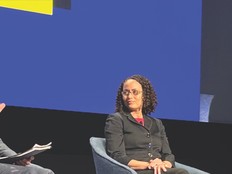Training the Next Generation
The Pension Benefit
Guaranty Corp. knows
all about retirement
planning. Several years
ago, the PBGC analyzed
demographic data on its
workforce and found troubling results:
Many of its IT workers were near
retirement. Within five years, the federal
agency would be in danger of having a
shortage of skilled workers in IT, as well
as in project and contract management.
So the agency, which insures private
sector pension plans and pays benefits for
retirees in failed plans, shifted into high
gear and initiated a pre-emptive effort to
keep its tech teams fully staffed.
PBGC launched a succession planning
initiative to develop and train a crop of
future leaders. Succession planning helps
attract and retain top-notch talent by
offering workers the training, mentoring
and experiences they need to develop
their skills and prepare for promotions.
In 2001, PBGC developed a leadership
training program to groom a steady
supply of well-qualified employees to fill
future management vacancies left by
retiring workers. Since then, PBGC has
expanded training offerings to all its
employees, including continuation of a
broad mentoring program, and it has
adopted rotational assignments, which
will enable workers to learn new skills by
working in different parts of the agency.
"It's helping us prepare a group of
highly qualified individuals for other
opportunities that may come in their
careers within the agency," says Patricia
Scott-Clayton, PBGC's deputy general
counsel for policy and regulations.
Gold Watch Time
PBGC is not alone in its efforts to train the
next generation of federal employees. In
recent years, the federal government has
emphasized succession planning to prepare
for the impending task of replacing
retirees. In 2001, 50.3 percent of all federal
government workers were 45 years or
older, according to the Nelson A.
Rockefeller Institute of Government in
Albany, N. Y.
This year, about one-third of all federal
workers (supervisors and non-supervisors)
will be eligible for early and regular
retirement, according to the Office of
Personnel Management (OPM). As more
baby boomers reach retirement age in the
coming years, that number is expected to
skyrocket. Among supervisory employees,
25 percent will be eligible for regular
retirement this year; that number will
nearly double to 47 percent by 2008.
Government is facing this worker
shortage for several reasons, researchers
say. Expansion of government programs
in the 1960s and 1970s created a huge
influx of government workers. Then, in
the workforce cutbacks of the late 1980s
and early 1990s, it was primarily younger
workers who lost their jobs, while more
experienced employees kept theirs,
according to a 2003 study by the Center
for Organizational Research based in
Lexington, Mass.
"If the workforce is older, but your
replacement pool of younger workers is
smaller, then you've got a pretty bad
combination," states Mary Young, the
report's author.
Other factors affecting the imminent
shortage, according to the report, include
reduced career development and training
opportunities, and a general lack of
interest in working for the public sector.
The long-term remedy is succession
planning, and OPM has been helping
federal agencies develop succession
plans since 2001. The agency is
launching a new 14-month leadership
training program for the Senior Executive
Service (SES), the civil service division
for top career executives in the federal
government. The SES Federal Candidate
Development Program is designed to give
workers the training they need to advance
as leaders in government.
The program, which is modeled
after similar programs created by the
Energy and Veterans Affairs
departments, will complement agency
succession planning programs and
provide smaller agencies with an
avenue to develop future executives.
Senior White House and Cabinet
officials will speak to participants and
lead workshops.
To help recruit and retain government
workers, OPM has also developed cash
incentive programs, including payment
of relocation expenses, recruitment
bonuses and picking up the tuition tab for
employees pursuing a college degree.
The agency also plans to establish entry-level employee recruitment programs to
attract talented workers, as well as a
leadership training program for mid-career
employees.
These types of efforts have come
none too soon. Labor Department
Assistant Secretary and CIO Patrick
Pizzella notes that agencies have long
spent time planning to replace outdated
technology and refurbish offices, so
implementing a similar effort for the
future workforce is a much-needed
step. He points out that a succession
plan can also help agencies make the
work environment more desirable by
providing training and incentives, such
as bonuses, to attract and keep good
government workers.
"We've done that [in Labor]," Pizzella
reports. "As a result, we've avoided a crisis
by being able to fill vacant positions with
capable people."
He adds that the key for agency
leaders who are about to embark on
succession planning is "Don't panic."
Even though a large percentage of the
workforce is eligible to retire, that doesn't
mean that they will retire immediately or
simultaneously, Pizzella points out.
But preparation is essential. Federal
agencies should review demographic
data on their workforce in order to
determine the skills they will need
during the next two to five years.
When Labor performed that exercise
several years ago, it discovered that
two-thirds of its senior executives were
eligible to retire within five years. It
also identified a need for employees who
had strong management and financial
experience to help run the agency.
To meet that need, the department
developed an MBA outreach program. To
recruit MBA graduates for the program,
Secretary of Labor Elaine Chao wrote
letters to every MBA school and to their
alumni association.
Recruitment Is Vital
An aggressive recruitment program is
also under way at the Tennessee Valley
Authority (TVA), a federal corporation
that provides power to large industries
and 158 local distributors, which serve
8.5 million consumers in seven states.
The average age of the TVA's 600 IT
workers is 47 years old, according to
Diane Bunch, senior vice president of
information services.
To bring down the average age of
employees, the TVA human resources
department recruits
recent graduates
from local colleges,
such as the University
of Tennessee. TVA
also relies heavily
on interns from
local colleges: At
any given time, the
IT department has
between 25 and
40 college interns.
When jobs open up,
the best-performing
interns are offered
full-time positions,
Bunch says.
"The part-time
employment helps
local students earn a
little money for
school, and if we have positions open at the
end of the internship, we can select from the
cream of the crop," she says.
One factor that has facilitated the
recruitment of IT workers is the dot-com
bust, which has encouraged some tech
professionals to consider government
employment. This is especially appealing
to IT workers who want the security that
usually comes with working for the
government. The clincher is that TVA can
now offer salaries and benefits competitive
with the private sector in geographic
locations in which it operates, Bunch says.
Even though outside recruitment is
essential, TVA's longtime employees are
not left out. In fact, they are offered a
variety of educational opportunities. In
a partnership with Vanderbilt University,
for example, TVA pays the tuition of
selected employees who spend part of their
weekends pursuing a master's degree in
business administration.
During the past five years, says Bunch,
TVA has also focused on individual
learning programs for its employees.
Supervisors work with their staff to
identify their goals and develop plans to
improve or acquire the skills they need to
reach those goals. The commitment
extends to skills that are new to the
marketplace as well as to the employee.
For example, the agency operates an
internal IT education department to
provide training on new technology.
In addition, supervisors mentor their
employees and encourage them to try new
duties occasionally in order to prepare
them for new roles and
potential promotions.
"We may have a great
technician who's interested
in becoming a project
manager, and when we
have an opportunity
to provide a different
experience, we allow
employees to broaden
their horizons," says
Bunch.
Succession planning
has resulted in a low
turnover rate among
TVA's IT staff. Training
and promotion programs
boost morale and build
loyalty, reports Bunch,
who started at TVA in a
clerical job 29 years ago.
When people do retire, TVA
generally has workers or interns in line
to replace them, which is important
because those people already know how
the agency works and can hit the ground
running. "Retaining our skill sets has
been a focal point for TVA," Bunch says.
Training Is Essential
An agency that is developing a leadership
training program may find that using an
outside consultant with expertise and
experience in succession planning can be
invaluable, says Ellen Roderick, director
of the PBGC Training Institute.
PBGC did just that to develop its
"Leaders Growing Leaders" employee
training program. Launched in 2001, the
two-year program trains employees in
leadership skills and lets them work in a
variety of departments to learn how
the entire agency operates. Developing
expertise in different areas within the
agency makes them attractive candidates
for future advancement. The program
also appoints senior executives as the
employees' mentors.
To find the best candidates for career
development programs, it's important to
have applicants go through a rigorous
application and interview process,
Roderick advises. In PBGC's case, six
board membersÂrepresenting a cross-section of the organizationÂreview
applicants' statements and credentials
and then select the applicants who best
meet the criteria. So far, 14 employees
have participated in the training.
Chief Management Officer John Seal
says the program has succeeded because
top management is involved in the
trainingÂand because it teaches skills
that are specific to PBGC's needs.
"An organization must recognize and
develop the talents of its key managers so
they have the potential to become leaders
in the future," Seal
points out. "It is
especially important
for a governmental
entity like the PBGC,
which cannot offer the
salaries and benefits
that private sector
firms can use to attract
and retain their
leadership pools."
Labor is a prime
example of an agency
that has had success
in its efforts to
recognize and develop
talent. In fact, the
department received
600 applications for
15 positions for its
two-year MBA outreach
program.
It also developed an 18-month Senior
Executive Service Federal Candidate
Development Program for employees in
the Labor Department and other
agencies, as well as workers in the private
sector. For that program, Labor received
150 applications for 30 positions.
Once workers complete the Candidate
Development Program, they are then
accredited to enter the Senior Executive
Service, which are the top managerial
jobs in the federal government.
In both efforts, the chosen
applicants receive leadership training
and work in a variety of positions
within the department. Of the first crop
of MBA participants, 12 have been
hired for full-time jobs at Labor, and
three have taken jobs elsewhere.
The first class of the Candidate
Development Program is about to
graduate. But even before classes ended,
Labor CIO Pizzella says, several in the class
had already been hired for SES jobs.
For mid-career professionals who
are not ready to step into the SES
program, Labor offers management
training classes for between 40 and 50
employees to help them develop the
skills they need to earn promotions.
Staying Put
Once an agency provides training and
education for its employees, it wants
them to stay around for a while.
To lessen the chances that its workers
will leave after they receive leadership
training, the PBGC
requests that its
candidates remain
with the agency for
at least three to five
years after they
complete the training,
says Scott-Clayton.
One aspect of the
training that helps
with retention, she
says, is that much of
what trainees learn
in the program is
specific to PBGC.
"Many exercises
are designed to
[help a person]
understand a
strategic area," she
points out.
"For example, we'll have them
attend a participant meeting, where
the agency goes out to address issues
of concern and explain what the
pensioners can expect from us in
the future. Things like that are unique
to our corporation."
One current "Leaders Growing
Leaders" participant, who expressed
appreciation for PBGC's dedication to
its employees and has no plans to
pursue job opportunities elsewhere, is
typical of graduates of the training.
The training is helping participants
understand their strengths and their
weaknesses, says David Harvey, deputy
director of PBGC's Contracts and
Controls Review Department. For
example, it helps IT staff develop skills
in areas such as communications,
strategic planning and policy
development.
"You might have someone who is
technically competent, but to be an
effective leader, you need to have
vision and the leadership skills to
interact with other people to produce
results," Harvey says. "This program
helps us look at that."
Succession planning is not just a
stop-gap measure to help PBGC
survive the impending influx of baby
boomer retirees. Instead, it's a smart
way to prepare the agency for its long-term needs.
Scott-Clayton compares succession
planningÂand the training initiatives
inherent in the effortÂto tending a
garden.
"We've planted the seeds that were
necessary," she says, "but the fruit
takes time to evolve."
SUCCESSION PLANNING
BREEDS EMPLOYEE LOYALTY
Because the Pension Benefit Guaranty Corp.
(PBGC) has made such a big investment in her
career, Joan Weiss feels a renewed commitment to
her employer. Now Weiss is paying the agency back
by using the skills she learned during training, as
well as with a currency that has little to do with
money: loyalty.
Weiss recently completed the federal agency's
two-year "Leaders Growing Leaders" program,
which helps workers build management skills.
Through this career development program,
employees spend time in different jobs in various
parts of the agency to learn from the inside how
each aspect of the agency contributes to the whole.
Trainees are guided through the process by a
mentor who is assigned to help them. This program
gives workers a big-picture view of how the agency
worksÂa perspective that employees can bring
back to their jobs.
The training is also fostering the loyalty that the
agency hoped to cultivate when the leadership
program was developed. Weiss, chief valuation
actuary at PBGC, says she is grateful for the time
and effort the PBGC has invested in her career. "I
was impressed by how much faith the corporation
showed in us by making an investment in resources
and our executives' time," she says.
During one three-month period, Weiss spent
about a quarter of her time in the leadership
program serving as the agency's problem resolution
officer, fielding complaints and questions from
customers and the public.
Later, she spent three months as a part-time
special assistant to PBGC Chief Operating Officer
Joe Grant, accompanying him to meetings with
other agencies, including the Labor Department.
The experience was invaluable, according to Weiss.
"He showed me what makes an effective meeting
and gave me exposure to senior-level processes,"
she explains.
Grant taught Weiss a lot about management. "I
got to see how he handles people and expresses
ideas," she says. "It's valuable to see what other
people do and then develop your own style."
The training also led Weiss to insights about
herself. One lesson she learned, Weiss says, is that
she needs to do a better job of allowing others to
express their thoughts.
"I'm fairly high-energy," she explains, "but I'm
trying to be a better listener and take it more
slowly."
While no one enjoys being told painful truths
about themselves, Weiss believes she can use the
experience to become a better employee, a better
coworker and a better manager.
"It makes you stronger," she says. "It's not about
me. It's about the organization and how each of us
can work and engage others to get the organization
where we want it to go."
LEAVING SOON?
Federal employees who are
planning to retire:
Within one year: 4%
Within 1 to 3 years: 12%
Within 3 to 5 years: 13.8%
Within five or more years:
70.2%
Source: Survey of about 100,000
federal employees, 2002 Federal
Human Capital Survey, Office of
Personnel Management
FOUR KEYS TO A STRONG SUCCESSION PLAN
1. Determine the skills your organization will need in the future
by identifying critical positions and areas where you expect
vacancies.
2. Recruit from colleges by offering internships. If positions open
up, hire your best interns.
3. Create career development and training opportunities for
employees.
4. Have supervisors mentor their employees and develop individual
career development plans. Help employees map out career goals
and develop a plan to help them learn the skills they need to
meet those goals.







